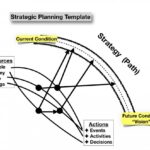1. Strategic Planning, a simplified template
Strategic Planning need not be a complicated process with a template that drives effective use of planning tools.

Strategic Planning need not be a complicated process with a template that drives effective use of planning tools.

Tactical verses Strategic Problem Solving Sometimes we address Strategic Problems with Tactical solutions and wonder why they fail in the long run. This causes us to question our decision making and problem solving processes, as it should. This example may help orient one to consider addressing root problems rather than symptoms of the problem. A simple example of decision making and problem solving at both the tactical and strategic levels lies with the struggle of fighting the common cold. When one has a cold, we look for remedies or medication to minimize the pains associated with the cold –…

10 Leadership Practices – Zimmer Principles. Successful organizations and senior leaders share a symbiotic relationship, but it’s the aspiring junior leaders that both will come to depend upon for their future successes. Cultivating junior leadership should be a key goal for organizations seeking a formative future. For consideration are ten leadership practices, or leadership principles that may prove helpful to the young, aspiring leader, and may serve as a reminder to a few old ones as well. 1 – Be You Many junior leaders select an exemplar to model themselves after by emulating their style in an attempt to achieve…

Informal leaders influence the workplace in ways we fail to understand at to our detriment. Find the accidental leader and leverage their influence.

Myths & Lies Organizational Myths and lies. Every organizations lies to perpetuate itself, and it enlists the aid of those who are perpetuated by it (knowingly or unknowingly). Every organization has myths about what behavior, actions, or practices will help its members get ahead. The challenge of the aspiring young employee is to know which myths are useful and which to avoid. That’s not easy because they can be ingrained in the very culture of the organization. One such ‘big lie’ that’s been around the Army for many years is that an officer should never pass up an opportunity to…

Situational awareness is the nexus that informs effective planning and decision making processes. Understanding the key constituent elements of situational awareness can take a leaders game to a more advanced level.

Symbiosis Critical elements to good leadership are confidence and competence. Confidence is easily discerned by those who follow. Employees will more willingly conform to their leaders influence when those leaders present a confident attitude about their business. A leader’s confidence is infectious. With a confident leader and confident staff, their mutual endeavors stand a better chance of achieving success because the ‘rank and file’ are more inclined to work in accord. People can immediately tell when a leader lacks confidence in themselves or the mutual endeavor the team is to undertake. If the leader cannot exude confidence about themselves, the…

Leadership through Tough Love? Sometimes when in a leadership position you find yourself preserving your sanity by being an Ass. I’m not sure it’s always a good thing, but sometimes it’s not bad. Soldiers come and go from platoons. On one occasion while leading a platoon in the 82d Airborne Division, we received a new soldier, fresh from truck driver and airborne schools. He was apparently a bit nervous, but also a bit cocky. This was not a bad combination, it was one the Platoon Sergeant, and I could easily deal with to integrate him effectively into the platoon. Unfortunately…

Top eleven ways to loose a referendum election